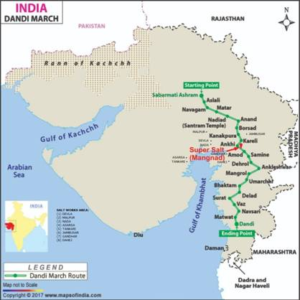In news: As part of AmrutMahotsav(75th Anniversary of Independence), Salt Commissioner Organisation organized a general health checkup programme for salt workers on Dandi March route
Saga salt production in India
- When India attained Independence in 1947, salt was being imported from the United Kingdom & Adens to meet its domestic requirement.
- Salt has played a vital role in changing the course of the history of our Nation. The workers in the salt pan continue to put in hard work for salt production and contributing to the development of India.
- In the pre-independence era, Indians were forced to buy imported salt at a very high cost and were barred from producing or selling salt locally.
- Dandi March by Mahatma Gandhi marks a very important Chapter in India’s Independence struggle.
Current status of salt production in India
- Currently, India is the third largest Salt producing Country in the World after China and USA with Global annual production being about 230 million tones.
- The Salt production has reached 30 million Tonnes(from less than 2 million Tonnes in the pre-independence era), meeting all human and industrial requirements and then exporting surplus to the tune of 5 million Tonnes to foreign countries worldwide.
- Salt, as a vehicle of nutrient supplementation (Iodine and Iron),has proven to be effective as we have enabled almost entire Population to have access to the Iodised Salt which has been effective in combating Iodine Deficiency Disorders.
The main sources of Salt in India are:
- Sea brine
- Lake brine
- Subsoil brine
- Rock salt deposits
Major Salt Producing Centers:
Sea water is an inexhaustible source of salt. Salt production along the coast is limited by weather and soil conditions. The major salt producing centres are
- Marine Salt works along the coast of Gujarat (Jamnagar, Mithapur,Jhakhar, Chira, Bhavnagar, Rajula, Dahej, Gandhidham, Kandla, Maliya, Lavanpur), Tamil Nadu (Tuticorin, Vedaranyam, Covelong), Andhra Pradesh (Chinnaganjam, Iskapalli, Krishnapatnam, Kakinada & Naupada), Maharashtra(Bhandup, Bhayandar, Palghar), Orissa (Ganjam, Sumadi) and West Bengal (Contai)
- Inland Salt Works in Rajasthan using lake brine and subsoil brine viz. Sambhar Lake, Nawa, Rajas, Kuchhaman, Sujangarh and Phalodi
- Salt works in Rann of Kutch using subsoil brine viz: Kharaghoda, Dhrangadhra; Santalpur
- Rock Salt Deposits at Mandi in the State of Himachal Pradesh
Salt Commissioner’s Organisation
- It has been entrusted with the task of Manufacture, Supply and Distribution of Salt by Union Agencies and by other Agencies.
- The Organization is an attached office of the Ministry of Commerce & Industry (Department of Industrial Policy & Promotion ) , Government of India. The Salt Organization has been entrusted with the task of Manufacture, Supply and Distribution of Salt by Union Agencies and by other Agencies.
- The Salt Organization is headed by the Salt Commissioner with its Headquarters at Jaipur (Rajasthan).
- There are five Regional Offices under him located at Ahmedabad, Chennai, Jaipur , Mumbai and Kolkata.
- The first four are headed by Dy. Salt Commissioner and the last by Asstt. Salt Commissioner.
Functions
The main functions of the Organization are:
- Implementation of Salt Cess Act,1953 and Rules made there under.
- Planning of salt production, arranging its equitable distribution and monitoring the quality and price
- Promotion of technological development and training of personnel.
- Promotion of salt exports and pre-shipment inspection.
- Nodal Agency for monitoring production, distribution and quality control of Iodised Salt under the National Iodine Deficiency Disorders Control Programme (NIDDCP) of Ministry of Health.
- Construction of dwelling houses for salt workers under ‘Namak Mazdoor Awas Yojana’ (NMAY)
- Planning, formulating and monitoring execution of development and labour welfare schemes.
- Collection of Salt Cess, Assignment Fee, Ground Rent and other dues.
- Rehabilitation of Salt works affected by Natural Calamities
Dandi March
- The Salt March, also known as the Salt Satyagraha, Dandi March and the Dandi Satyagraha, was an act of nonviolent civil disobedience in colonial India led by Mahatma Gandhi
- The twenty four day march lasted from 12 March 1930 to 5 April 1930 as a direct action campaign of tax resistance and nonviolent protest against the British salt monopoly.
- Another reason for this march was that the Civil Disobedience Movement needed a strong inauguration that would inspire more people to follow Gandhi’s example.
- Gandhi started this march with 78 of his trusted volunteers
- The march spanned 240 miles (390 km), from Sabarmati Ashram to Dandi, which was called Navsari at that time (now in the state of Gujarat)
- When Gandhi broke the British Raj salt laws on 6 April 1930, it sparked large scale acts of civil disobedience against the salt laws by millions of Indians

















